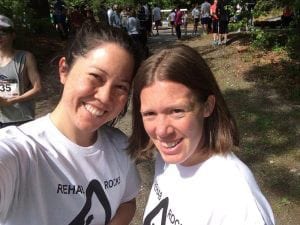In collaboration with the Hereditary Neuropathy Foundation (HNF), Patient Worthy asked members of the Charcot-Marie Tooth (CMT) community to tell us their stories, in hopes of inspiring everyone in the rare community to keep fighting.1
The essay winner Sarah Magno, will receive to tickets to Set Sail for CMT, an HNF event created to raise money for further CMT treatment development.
The following essay was written by 32-year-old Sarah Magno, battling CMT and not letting this adversity define her.
Rare disease? I know that I say I am special but having a rare disease seemed a bit much. Charcot-Marie-Tooth (CMT) was brought to my awareness two years ago after I injured the top of my foot running on the treadmill. I don’t even like the treadmill! Clearly, I was on it for a reason.
This wasn’t the usual injury like I had when I was growing up; I used to twist my ankle all the time. I’d hear a pop, get up, and keep going. They gave me some nice ankle wraps to wear but it wasn’t really looked in to. They put me in a cast several times after a couple of especially good sprains but that really didn’t do much except slow me down. Once, they said that it was for a sprain. A second time, they said it was for a bone spur. This didn’t stop me from playing soccer because, as I was not actually injured, I didn’t see the reason for the cast. (In retrospect, this was a terrible idea but kids will be kids and I loved to play sports.)
This time, when the podiatrist checked out my food for the treadmill injury, he noticed that I had slight hammertoe and asked me about my regular footwear. Being taller than average, I usually avoid heels and stick to flats when I have an event to go to. ‘What does this have to do with the top of my foot?’, I thought, but he’s the one with the letters after his name so who am I to ask such questions. Then he asked me about my history of ankle injury as he was testing my ankle strength. Again, ‘what does this have to do with the top of my foot?’ He had me walk down the hallway as he observed my feet and, after I paced around for a minute, he said I had drop foot and possibly something called CMT. The look on his face told me that this, indeed, had nothing to do with the top of my foot.
I knew that I had a funny and bouncy style of walking but I had never heard of this “CMT” before. After being referred to different specialists, getting stabbed by needles and essentially tasered (the EMG and NCV), and ruling out MS, they said that they believe I have a de novo mutation of CMT Type 2. The specialists themselves didn’t really know a ton about CMT so what was the first thing that I did when I got home? Looked it up on the internet. (This is one of the dumbest things to search for, falling in line with looking up “what kind of spider is this”.) It is, in fact, no relation to Country Music Television, which I imagine I will have to explain to people for the rest of my life.
I spent a good couple months freaking out about all of it. (Will I pass it to my future children? Will my legs deteriorate? Will I play piano or flute anymore? Will I still type 80 words per minute on the computer?!…clearly the first two being most important followed by spiraling out of control questions.)
The specialist said that they didn’t believe physical therapy would make a difference. Because I was still in shock, I believed them even though they said they didn’t really have a good understanding of CMT. It was only after I spoke with my mother-in-law about her Parkinson support group that she attends, did I realize that I should look for a support group for my own rare disease and figure out what I can do and stop focusing on what I may not be able to do.
I found a wonderful group on Facebook for CMT Athletes and it has helped me to push myself through frustrating days and enjoy my big calves while I have them.

For the past couple years now I have been rocking some beautiful purple AFOs, the kind that look more like shin guards than leg braces. They have helped me to feel stable while walking, allowed me to feel confident on uneven terrain, and it also protected my shin from rogue softballs while playing as catcher for our adult league (yes, I still love sports). I tried WalkAide devices for a while but, unfortunately, my insurance would not cover them.
I will continue to stay active and hope to expand my network of fellow CMT-ers while keeping a positive attitude.
This essay is more about finding confidence with a rare disease and now that there is more information available that describes CMT in words I can understand, I feel confident that my life will continue to be awesome… just with different shoes and legwear.
Congratulations to Sarah for inspiring all of us on the Patient Worthy team! Share her story today and if you want to share your own, click here.






